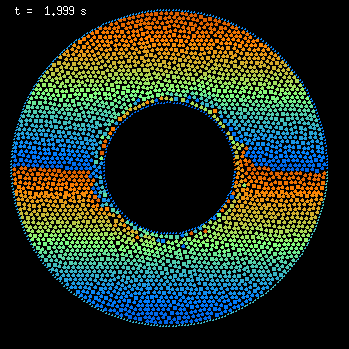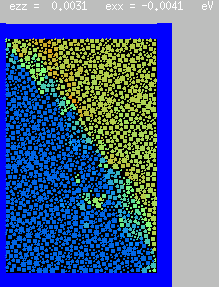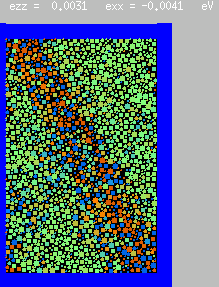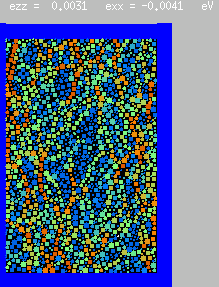pictures
On this page you can find pictures and the visualization tool
xballs (by lui) ...
The computer generated pictures on this page were created using xballs.
You can get the source code (Version 1.95 from 140599):
xballs.c,
a program description
xballs.txt,
and a sample make-script for a few architectures (DEC, SUN, LINUX) xballs.make.
Finally you need two small include files:
functions.h, and
patchlevel.h.
Compilation under WINDOWS has been successfuly performed by Ramanan Pitchumani - thanks.
Alternatively you get all of that together tared and gzipped by clicking
here.
The newer version (1.96 from May 2001) is also able to do 3D graphics
(don't expect too much :-).
The latest version (1.97 from May 2002) has only a few more options.
The very latest version (1.99 from September 2005) has quite more options.
And finally an even newer version (2.01 from September 2008) has quite more options.
Shear-cell simulations (Nov. 2001)

Biaxial compression simulations (Sept. 2001)



Different forcelaws (Aug. 2001)




EXTREMELY BRANDNEW - A film of an MD simulation of a ring-cloud
around a central force
ring
(1.87 MB)
and the large version of this film
large ring (7.8 MB). The color code indicates the tangential
velocity, where red, green and blue correspond to large, medium and
small values, respectively.
A film of a spaceship passing by a planetary ring system with
a
moon
(2.10 MB).
CLUSTERING - snapshots from an ED simulation with N=99856 particles
in 2D and periodic boundary conditions. The system cools due to
dissipation so that 10 per-cent of the relative velocity is lost
per collision (r=0.9). The three figures are from the same simulation
and the color code means
kinetic energy (3.35 MB),
collision rate (2.62 MB) or
initial vertical position (3.10 MB). Red, green and blue correspond
to large, medium and small values, respectively.
BRANDNEW - A film of an ED simulation of membrane dynamics.
The membrane - initially a flat square - contains 93x93 spheres
of diameter d, the neighbors are connected with strings of length
0.2 d. You view the membrane from the side - red corresponds to
the particles close to you, blue to those far away.
Click to view the low resolution mpeg-film (94kB):
 , high resolution (short) (1MB), or high res. (long) (2.3MB). For a full 3D
view of the dynamics of a membrane see 3D video.
If the mpeg_play command produces bad colors then try the `-dither color'
option for 24bit-color hardware or the `-dither fs2' option for 8bit-color
hardware (much slower).
, high resolution (short) (1MB), or high res. (long) (2.3MB). For a full 3D
view of the dynamics of a membrane see 3D video.
If the mpeg_play command produces bad colors then try the `-dither color'
option for 24bit-color hardware or the `-dither fs2' option for 8bit-color
hardware (much slower).
ring-shock wave 1 -
ring-shock wave 2
NEW - A film of an ED simulation of surface waves - here one frame
per period at fixed phase (445kb). Thanks to Steffen Schöllmann.
FILM
A series of frames from an ED simulations of 1562 particles falling in
a vertical pipe. The colorcode gives the number of collisions during the
last millisecond. The corresponding reference is
S. Luding, J. Duran, E. Clement, J. Rajchenbach, J. Phys. I 6, 823 (1996).
t=0.052 s
t=0.054 s
t=0.056 s
t=0.058 s
t=0.060 s
Two snapshots of two simulations showing the direction of rotation
for each particle. Blue and red correspond to clockwise and
counterclockwise rotation respectively.
RUN 1, t=0.030 s
RUN2, t=0.072 s
Snapshots of simulations of particles in a vibrating container. Surface
waves for different frequencies of agitation.
N=2800, H=14, G=3.6, f=14.4Hz
N=2800, H=14, G=3.6, f=12.5Hz
N=2800, H=14, G=3.6, f=8.3Hz
A picture of Stefan Luding under the christmas tree








 , high resolution (short) (1MB), or high res. (long) (2.3MB). For a full 3D
view of the dynamics of a membrane see 3D video.
If the mpeg_play command produces bad colors then try the `-dither color'
option for 24bit-color hardware or the `-dither fs2' option for 8bit-color
hardware (much slower).
, high resolution (short) (1MB), or high res. (long) (2.3MB). For a full 3D
view of the dynamics of a membrane see 3D video.
If the mpeg_play command produces bad colors then try the `-dither color'
option for 24bit-color hardware or the `-dither fs2' option for 8bit-color
hardware (much slower).